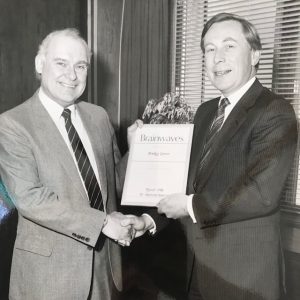
My dad, Stan Gower started working as a sheet metal worker for British Airways in 1974. We lived about 7 miles from Heathrow and I remember he used to avoid the traffic jams by driving there and back every day on a Lambretta scooter.
In 1988, British Airways was in a period of change after its privatisation the previous year. When they re-launched their staff suggestion scheme called Brainwaves, it was heralded as one of the biggest and most successful company savings and suggestions schemes in Britain at the time.
According to a British Airways staff news supplement the Brainwaves re-launch, was designed to give a fresh boost to the scheme and encourage all staff, and in particular more people from non-technical areas to get involved. The top award was doubled from £5,000 to £10,000 and the application process made more user-friendly. They also pledged to speed up response processing times to just six weeks! Their target was to save £2million over 12 months. That was big money back then.*
Brainstorm your way to a £10,000 bonus
Stan Gower likes a challenge and I expect the “Brainstorm your way to a £10,000 bonus” headline in the staff paper piqued his interest. (£10,000 is worth about £26,000 in today’s money)
Before joining British Airways Stan had worked in small companies where he was used to finding alternative ways to making a job more efficient. This is especially motivating when you are paid on the quantity and quality of your output.
Stan was the first British Airways employee to win the top prize of £10,000 for his brainwave.
Stan was spending a lot of time on a recurring problem with a Rolls Royce RB211 engine used on Boeing 747s. In laymen’s terms a bit of the engine called the ‘front bellows’ was subject to rubbing from other pipes located next to it and practically every time an engine went into the workshops the front bellows of the engine had to be replaced at great cost. Apparently the job was called ‘the trouser leg job’ in the workshop owing to the shape!
Stan’s first suggestion was to bend the offending pipe out of the way. However, experts in engineering disagreed. It’s fair to say that Stan doesn’t like being told ‘no’ and wouldn’t let it rest there so he went off to think of another solution.
His winning idea was to fit a protective cover over the front bellows. It was trialled for a year and it worked so well that front bellows replacement is now rarely necessary.
“When it comes to changing something in a large organisation, not only do you have to have the idea – having recognised the problem but also sufficient tenacity to see it through because you have to jump through hoops, whereas in other, smaller places you just get on with it.”
Below is Stan with British Airways Chairman, Sir Colin Marshall receiving his certificate. The Gower’s went on a nice holiday that year.

Over the years the British Airways employee suggestion scheme received 100’s of ideas. Small ideas like descaling the toilet pipes on planes, making them lighter and saving fuel, replacing glass wine bottles with plastic bottles, washing/cleaning the engines more regularly, switching to lighter catering trolleys and cargo containers and the introduction of lighter cutlery have added up to save the company over £20million.
However, since the 1980’s, research into employee motivation has meant that employee suggestion schemes have evolved, many are moving away from the monetary reward ‘carrot and stick’ approach and focusing on how to inspire employees.
For example Dan Pink, author of books about work, management, and behavioural science uncovered a surprising truth about what motivates us.
The British Airways Brainwaves scheme is a typical way to reward top performance ideas; where ideas that have more impact on profitability get bigger rewards. Dan found that this works up to a point. His findings show that it works as long as the task involves mechanical skill – like Stan’s work in smaller companies where you get paid on your output. However, once the task involves creative or conceptual thinking monetary rewards actually lead to poorer performance.
Let’s be clear that money is a motivator, in that people have to be paid enough. If people are underpaid they struggle to be motivated. However Dan Pinks findings, as well as that of other sociologists, psychologists and behavioural economists indicate that the true key to motivation lies in three interconnected areas.
- Autonomy – the permission to be self-directed in your work and your development. When managers get out of the way and let you get the work done in the way that you want to.
- Mastery – this is our urge to get better at stuff, why we practice sports, music, writing or whatever it is that we want to master.
- Purpose – how we make a contribution, whether that’s making life better for customers or for co-workers. Having purpose makes coming to work better, attracts talent and over time research has shown, leads to profit.
For more check out Dan Pinks RSA animate film.
Who knows what happened to the Brainwaves scheme. Does it still exist or did it evolve? It’s been impossible to talk with anyone at British Airways about how they approach innovation. If you are reading this and can help please do get in touch.
*That’s just over £5million in real terms today.
